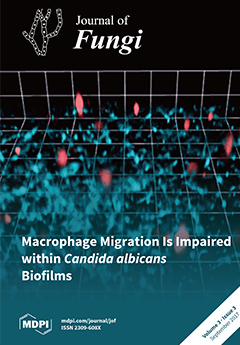We investigated the role of
KEX2,
SAP4-6,
EFG1, and
CPH1 in the virulence of
Candida under a novel compound 2-bromo-2-chloro-2-(4-chlorophenylsulfonyl)-1-phenylethanone (Compound
4). We examined whether the exposure of
C. albicans cells to Compound
4, non-cytotoxic to mammalian cells,
[...] Read more.
We investigated the role of
KEX2,
SAP4-6,
EFG1, and
CPH1 in the virulence of
Candida under a novel compound 2-bromo-2-chloro-2-(4-chlorophenylsulfonyl)-1-phenylethanone (Compound
4). We examined whether the exposure of
C. albicans cells to Compound
4, non-cytotoxic to mammalian cells, reduces their adhesion to the human epithelium. We next assessed whether the exposure of
C. albicans cells to Compound
4 modulates the anti-inflammatory response (IL-10) and induces human macrophages to respond to the
Candida cells. There was a marked reduction in the growth of the
sap4Δsap5Δsap6Δ mutant cells when incubated with Compound
4. Under Compound
4 (minimal fungicidal concentration MFC = 0.5–16 µg/mL): (1) wild type strain SC5314 showed a resistant phenotype with down-regulation of the
KEX2 expression; (2) the following mutants of
C. albicans:
sap4Δ,
sap5Δ,
sap6Δ, and
cph1Δ displayed decreased susceptibility with the paradoxical effect and up-regulation of the
KEX2 expression compared to SC5314; (3) the immune recognition of
C. albicans by macrophages and (4) the stimulation of IL-10 were not blocked
ex vivo. The effect of deleting
KEX2 in
C. albicans had a minor impact on the direct activation of Compound
4’s antifungal activity
. The adhesion of
kex2Δ is lower than that of the wild parental strain SC5314, and tends to decrease if grown in the presence of a sub-endpoint concentration of Compound
4. Our results provide evidence that
SAP4–6 play a role as regulators of the anti-
Candida resistance to Compound
4. Compound
4 constitutes a suitable core to be further exploited for lead optimization to develop potent antimycotics.
Full article






